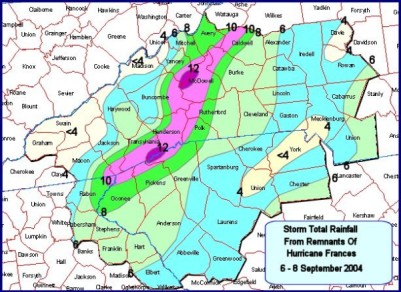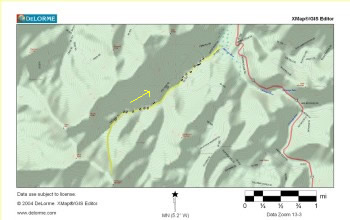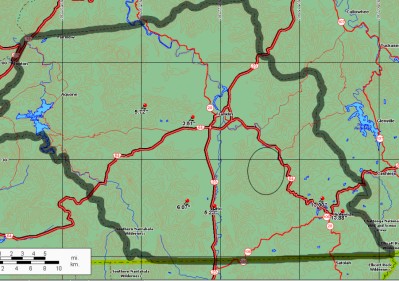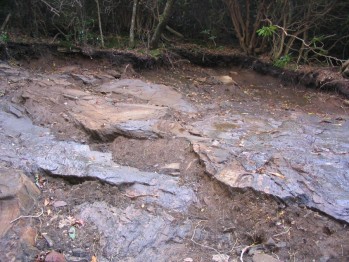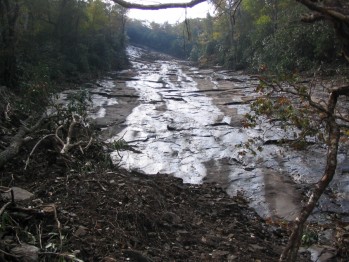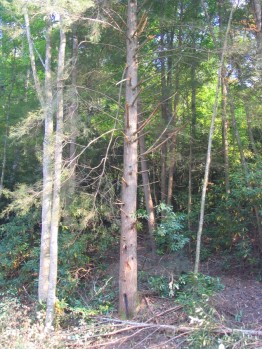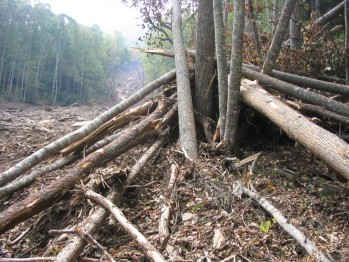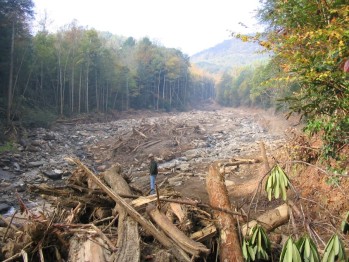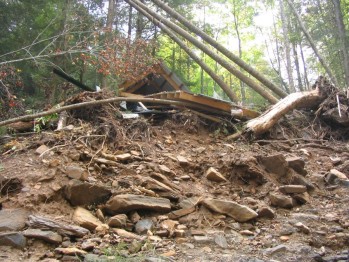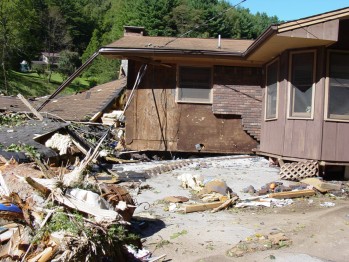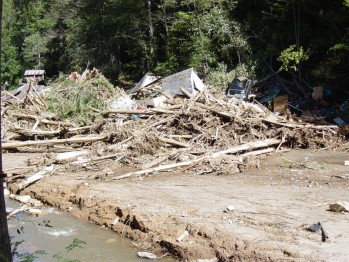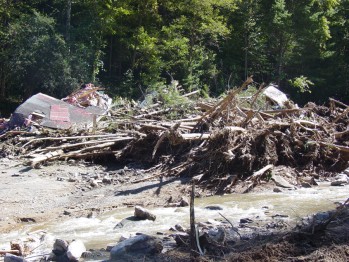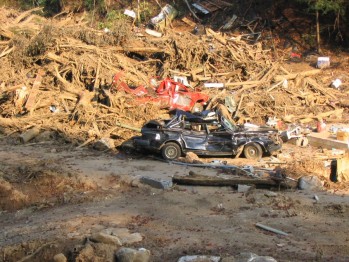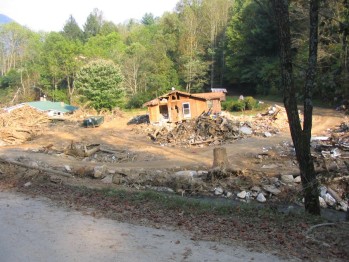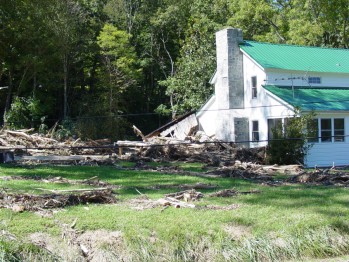If you were in Highlands in September 2004, you wouldn't forget Hurricane Ivan. This incredible amount of rainfall (excess of 25") and wind was devastating to the area. This paper cover those events and the tragedy that occurred at the bottom of the Gorge Rd, in the Peek's Creek area.
The Deadly Debris Flow in Macon County NC During Hurricane Ivan
Jonathan R Lamb
NOAA/National Weather Service Greer, SC |
I. Introduction
The remnants of Hurricane Ivan tracked up the spine of the Appalachian Mountains 16-17 September 2004. The track of Ivan was remarkably similar to that followed by Hurricane Frances ten days earlier, moving northeast from northern Georgia along the North Carolina - Tennessee border. The track of both systems along the spine of the Appalachians concentrated the highest rainfall totals in western North Carolina. Frances produced widespread rainfall amounts of 8 to 12 inches, while 6 to 10 inches were common with Ivan. The southern mountains of North Carolina, including Macon County, received the highest rainfall totals during both tropical systems. On the night of Thursday, 16 September, heavy tropical rains had inundated Macon County for several hours. At 10:00 p.m. EDT near the peak of Fishhawk Mountain, approximately 6.5 miles southeast of Franklin, a layer of soil liquefied and began flowing down Peeks Creek. Due to the very steep terrain and abundance of loose surface material, a large debris flow formed and moved down Peeks Creek (Note: The term for this type of slope movement is "debris flow" as defined by the U.S. Geological Survey because it better describes the constituents of this semi-liquid transient mass). The Peeks Creek housing community sits along Peeks Creek near the bottom of Fishhawk Mountain, about one-quarter mile above the Cullasaja River. The massive debris flow destroyed about 15 homes in a matter of seconds, killing four people and seriously injuring several more. As is the case with most debris flows, the conglomeration consisted of very little water by the time it reached the houses.
|
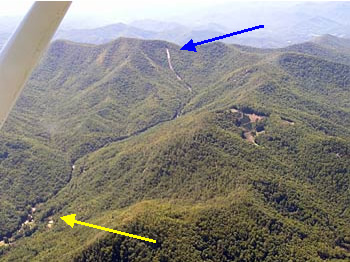 | 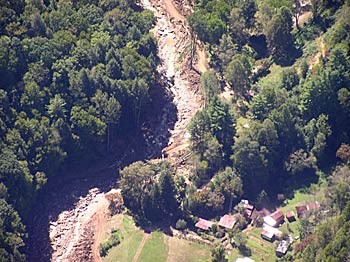 | |
Figure 1. Aerial photograph showing the Peeks Creek watershed. Debris flow began near top of Fishhawk Mountain (blue arrow) and moved through the Peeks Creek community (yellow arrow). Photo courtesy of David Phillips.
|
Figure 2. Zoomed aerial photograph showing the portion of the Peeks Creek community that sustained the most damage. Most of the brown parts are house rubble strewn about. Photo courtesy of David Phillips.
|
II. Meteorological Background
Hurricane Frances made landfall near Sewall's Point, Florida, around 1:00 a.m. EDT, on 5 September 2004, as a Category 2 storm on the Saffir-Simpson Hurricane Scale. Frances moved west-northwest across central Florida early Sunday morning and was downgraded to a tropical storm at 5:00 p.m. EDT that day 20 miles east of Tampa.
|
Frances emerged in the northeastern Gulf of Mexico at around 11:00 p.m. EDT, just north of Tampa. The system regained tropical storm status as it moved across the northeast Gulf of Mexico on 6 September, then made a second landfall at Saint Mark's, Florida, at 2:00 p.m. EDT with maximum sustained winds of 65 mph. Frances weakened rapidly as it moved north-northwest across southwestern Georgia on Monday evening, 6 September.
The remnants of Frances moved through north-central Georgia, across the extreme western tip of North Carolina, then up the spine of the Appalachian Mountains through 8 September. Very gusty winds and torrential rain buffeted the western Carolinas and northeast Georgia. Widespread severe flooding occurred, especially along the French Broad and Swannanoa rivers through Asheville and Biltmore. Only a few landslides were reported with Frances, probably because antecedent soil moisture was low.
Almost exactly ten days after Frances' landfall, powerful Hurricane Ivan churned toward the Gulf coast as a Category 4 storm. Shortly before landfall, Ivan weakened slightly to Category 3 strength, with maximum sustained winds near 130 mph. The center of Hurricane Ivan moved onshore near Gulf Shores, Alabama, at around 3:00 a.m. CDT on Thursday, 16 September 2004. Ivan weakened rapidly as it moved north and then northeast across Alabama on Thursday. Ivan was downgraded to a tropical storm at 2:00 p.m. CDT on Thursday when it was located 45 miles west-northwest of Montgomery, Alabama. Maximum sustained winds had decreased to 70 mph. Ivan was downgraded to a tropical depression late Thursday evening while centered 25 miles north-northwest of Gadsden, Alabama. Maximum sustained winds had dropped to near 35 mph with a minimum pressure of 986 milibars.
The system remained a tropical depression as it slowly moved northeast across northwestern Georgia and eastern Tennessee Thursday night and Friday morning. By 11:00 a.m. EDT on Friday the 17th, the depression was located 45 miles east of Knoxville, Tennessee. Widespread heavy rain affected western North Carolina Thursday night and Friday. Wind gusts reached between 40 and 60 mph across the higher elevations of the Appalachians. Numerous trees were downed, flooding was widespread, and numerous slope failures occurred. Rainfall amounts reached 8 to 12 inches across parts of the region. The debris flow was triggered late Thursday evening as Ivan's rains were at their greatest intensity. Several geological studies in the past 25 years have shown that the best primer for widespread slope failures is high antecedent moisture conditions followed by intense bursts of rain (Neary and Swift 1987). The amount and duration of precipitation needed for widespread slope failures varies, but one geological study in the eastern United States found that a minimum of only five inches of rain in 24 hours was necessary (Eschner and Patric 1982). This condition was easily met in the North Carolina mountains during Ivan.
|
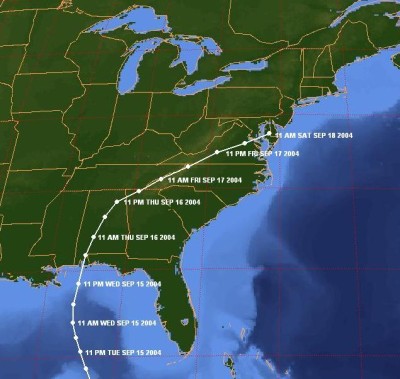 | 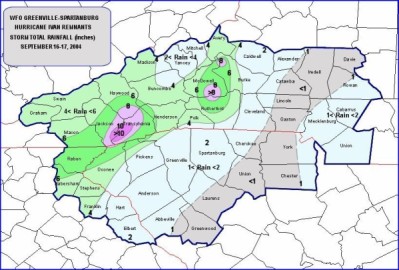 |
| Figure 5. Track of Hurricane Ivan. | Figure 6. Regional rainfall from Hurricane Ivan. Data has been smoothed significantly to allow contouring. |
A tropical system track just west of the Appalachian Mountain spine is a worst-case scenario for flooding and landslides from a meteorological perspective. During September 2004, two storms did just that. Although a tropical cyclone immediately begins to weaken over land, the system is still a strong low pressure system well inland. The flow in a low pressure system is approximately counterclockwise relative to the center. Therefore, to the right of a northward moving system, a generally south or southeast wind will occur until the low center passes a given location. Since the Gulf of Mexico and Atlantic Ocean are the primary sources of moisture for this area, a southerly wind will provide the most moisture transport. Also, precipitation is enhanced when a strong southerly flow of moist air affects a surface barrier like the Appalachians.
|
Local to the Peeks Creek basin, Fishhawk Mountain comprises a small mountain ridge that runs from northwest to southeast. In a strong moist, southerly flow, this could slightly enhance the localized precipitation efficiency by maximizing the upslope wind component. Although some precipitation reports were received around Macon County, no residents near Fishhawk Mountain could be found with an accurate rainfall total for comparison purposes. The limited rainfall reports shown in Figure 9 doinfer much heavier rain around the landslide initiation point than to the west near Franklin. Due to terrain blockage in the southwest North Carolina mountains, the KGSP and KMRX WSR-88D radars provide only limited data on precipitation intensity and accumulated rainfall estimates.
| ||
| Figure 7. Local topography of the Peeks Creek watershed. Fishhawk Mountain is in the lower-left and the yellow trace indicates the path of the debris flow. The Cullasaja River is just left of US Highway 64 in the upper-right. |
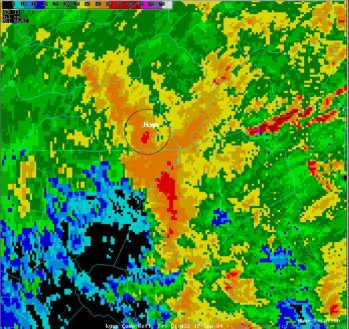 | 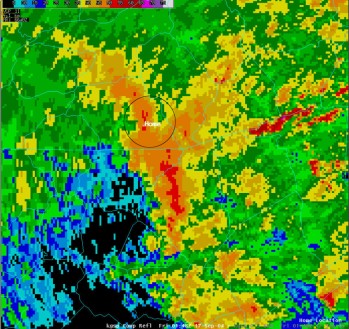 |
| Figure 8a. Composite Reflectivity image from KGSP WSR-88D at 0143 UTC (9:43 p.m. EDT). Circled area shows the general region while the home cursor is positioned at Fishhawk Mountain. Notice enhanced 50-55 dbZ returns approaching the area. | Figure 8b. Composite Reflectivity image from KGSP at 0148 UTC (9:48 p.m. EDT). Notice the enhanced 50-55 dbZ returns over Fishhawk Mountain. The landslide occurred at approximately 0200 UTC (10:00 p.m. EDT). |
III. Evolution of the Event
At approximately 10:00 p.m. EDT, after four to six inches of rain had soaked southeastern Macon County, a portion of Fishhawk Mountain failed. The sheet of loamy soil that liquefied was only two to three feet deep, below which lay solid bedrock. The slope at initiation was about 50 degrees with an elevation of nearly 4450 ft MSL. A natural spring originated near the pinnacle of Fishhawk Mountain and likely contributed to this part of the slope giving way. This spring was trickling two weeks after the event when the author toured the area. The flow of water through the spring probably increased drastically during the heavy rains of Ivan. Given the geological and hydrological setup, it is not surprising that this particular slope failure occurred.
|
 |
| Figure 15. Panoramic photograph of the wide area. Immense pile of rocks and organic debris can be seen in the center. The stream flows from right to left in this image. |
Just below the wide area, the creek steepened and narrowed, accelerating the remaining debris. Two uninhabited vacation cabins became the first victims of the slide at this point. They were both total losses. Prior to the event, Fishhawk Mountain Road crossed the creek near the two cabins then proceeded up one side of the creek bank to several other undisturbed vacation cabins. The slide totally scoured away the roadbed, isolating the remaining cabins for over a month until a temporary access road could be constructed.
|
Figure 16. One of the destroyed vacation cabins.
|
A few tenths of a mile below the cabins stood the Peeks Creek community, a series of about 20 houses, most of which were inhabited year-round. Most of the structures were situated very close to the creek bed, but as residents noted, in the last several decades the creek had never risen high enough to threaten the homes. According to the North Carolina Geological Survey, the flow of debris barreled through the community at about 30 miles per hour, with a peak discharge of 45,000 cubic feet of material per second (Fig. 23). For comparison purposes, this is about three times the mean discharge of the French Broad River at Asheville, North Carolina.
In a matter of seconds the torrent crashed through about 15 homes, reducing some to splinters, while pushing others off their foundations and severely damaging them. Four fatalities occurred, along with several serious injuries. Just beyond the houses, the terrain leveled off into a grassy plain. The flow of debris, including parts of the homes, slowed down and spread out at this point. Three detached sheds near a large house were flattened by the remaining flow before it concluded at the Cullasaja River. This was at about 2250 ft MSL. The entire event took place over a vertical elevation change of about 2200 feet during a period of 15-30 minutes.
|
IV. Future Mitigation Efforts
The US Geological Survey and North Carolina Geological Survey are actively involved in debris flow research. They are attempting to map regions with a heightened risk of slope failures for use by municipal planners and prospective residents of steep terrain. The task, however, is monumental, due to the sheer quantity of rugged terrain yet to examine.
Considerable improvements to short-range landslide prediction and public awareness are also underway. The U.S.G.S. has, for several years, issued official Landslide Advisories for broad regions one to three days in advance of anticipated widespread slope failures. The North Carolina Geological Survey started issuing Landslide Advisories for more specific areas of western North Carolina in 2004. A collaborative effort between the US Geological Survey, N.C. Geological Survey, and National Weather Service has recently taken shape. More effective dissemination of the landslide advisories or the information they contain is under consideration by the involved agencies. Also, an integral part of these landslide predictions is accurate quantitative precipitation forecasts (QPF). The unusually large number of landslides during the 2004 tropical season has prompted a new partnership between the NOAA National Weather Service (NWS) and the U.S.G.S. The U.S.G.S. plans to directly utilize precipitation forecasts from the NWS for their landslide products.
This event illustrates a need for improved landslide awareness by residents of the higher terrain. Simply because flooding is not common in a given location does not imply a reduced risk of a slope failure and/or debris flow. Through the mapping work being done by geological officials and an ongoing public education campaign, future fatalities due to debris flows will hopefully be prevented.
|
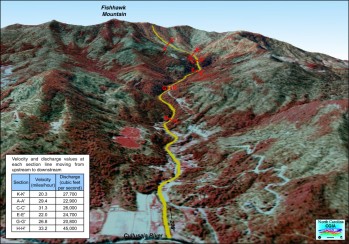 | |
| Figure 23. A detailed analysis of the Peeks Creek debris flow from the North Carolina Geological Survey. The flow velocity and estimated discharge were calculated at several places along the path. |
V. Additional Information
The United States Geological Survey has a plethora of information about landslides on their website.
The North Carolina Geological Survey is tasked with studying the individual events that affect the state. They played the central role of researching the Peeks Creek disaster and reporting the findings. Their website contains detailed information and pictures from many landslides.
NOAA's National Weather Service issues a full suite of forecasts and warning products for the entire U.S. and its territories.
The Hydrometeorological Prediction Center, a branch of the NOAA National Weather Service, issues quantitative precipitation forecasts (QPF) for the entire U.S. Their entire suite of QPF products can be found here.
The Federal Emergency Management Agency (FEMA) has a website devoted to landslide safety and preparation.
|


